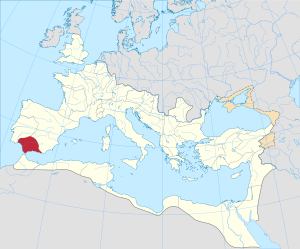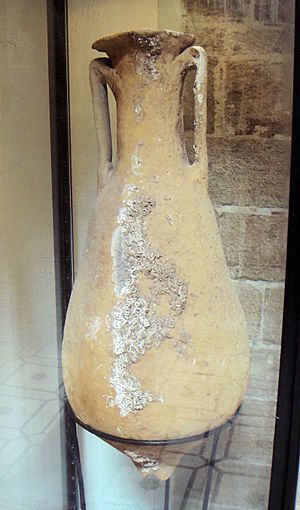Hispania Baetica facts for kids
Quick facts for kids Provincia Hispania Baetica |
|||||||
|---|---|---|---|---|---|---|---|
| Province of the Roman Empire | |||||||
| 14 BC–5th century | |||||||
 The Roman province of Hispania Baetica, around 125 AD |
|||||||
| Capital | Corduba | ||||||
| Historical era | Antiquity | ||||||
|
• Established
|
14 BC | ||||||
|
• Visigothic conquest
|
5th century | ||||||
|
|||||||
Hispania Baetica, often called Baetica, was one of three important Roman provinces in Hispania, which is what the Romans called the Iberian Peninsula (modern-day Spain and Portugal). Baetica was located in the south of the peninsula. To its west was Lusitania, and to its northeast was Hispania Tarraconensis.
Baetica remained a key region even after the Romans, under the Visigoths until 711 AD. Later, in the 8th century, it became part of Al-Andalus when the Arabs conquered the area. Today, this region roughly matches the area of modern Andalusia in Spain.
Contents
What's in a Name?
The name Baetica comes from the Latin word Baetis. This was the Roman name for the Guadalquivir River. The fertile valley of this river was a very important part of the province. So, the name Baetica simply means "land of the Baetis river."
Baetica's Ancient History
Before the Romans arrived, the mountainous area of Baetica was home to several local tribes. The most powerful group was the Turdetani, who lived in the Guadalquivir valley. Near the coast, there were also Phoenician trading cities like Cadiz (called Gadira by the Romans). These cities had a strong influence on the region.
Some of the ancient cities in Baetica kept their original names even during Roman times. For example, Granada was known as Eliberri or Illiberis. In the Basque language, "iri-berri" or "ili-berri" means "new town."
Roman Arrival and Rule
The southern part of the Iberian Peninsula was very rich in agriculture. It produced wine, olive oil, and a special fermented fish sauce called garum. These products were important for trade around the Mediterranean Sea even before the Romans took control in 206 BC.
After Carthage was defeated in the Second Punic War, the Romans began to take over Hispania. The local tribes, like the Turdetani, tried to fight back in 197 BC, but the Romans eventually won. By the end of the Roman Republic, Hispania was divided into two main provinces: Hispania Citerior (closer to Rome) and Hispania Ulterior (farther away).
In 14 BC, the Roman Empire was reorganized. Baetica became a "senatorial province." This meant it was governed by a proconsul, a high-ranking Roman official. Baetica was very prosperous and peaceful, earning it the nickname Baetica Felix, meaning "Happy Baetica." It was so safe that no Roman legion (a large army unit) was needed there permanently.
Life and Economy in Baetica
Baetica was divided into four main areas called conventūs. These were like judicial districts where important local leaders would meet with the proconsul to manage justice. Over time, these centers became permanent courts.
The province was famous for its huge olive plantations. Olive oil from Baetica was shipped by sea to supply Roman legions in places as far away as Germania. You can find amphoras (large clay jars) from Baetica all over the Western Roman empire, showing how widespread its trade was.

The Roman Emperor Vespasian gave the people of Hispania the Ius latii. This special right gave them many of the same benefits as Roman citizens. This made the wealthy and middle-class people of Baetica very loyal to Rome.
Interestingly, the Roman Emperor Trajan, the first emperor born outside of Italy, came from Baetica. His relative and successor, Hadrian, also had family roots in Baetica.
End of Roman Rule
Baetica remained Roman until the 5th century AD, when groups like the Vandals and Alans passed through. Then, the Visigoths established a more lasting kingdom. Later, in the 8th century, the Arabs conquered the region, and it became known as "al-Andalus."
Important Governors
The province of Baetica was governed by a proconsul. These were important Roman officials, often former praetors, who were in charge of the province's administration and justice.
See also

- Pre-Roman peoples of the Iberian Peninsula
- Romanization of Hispania
- Spania

